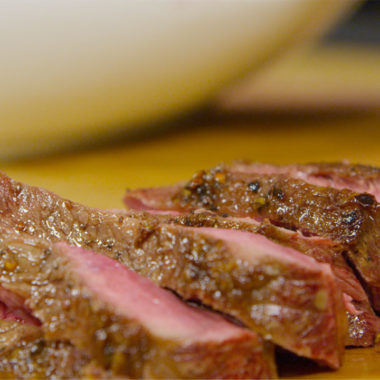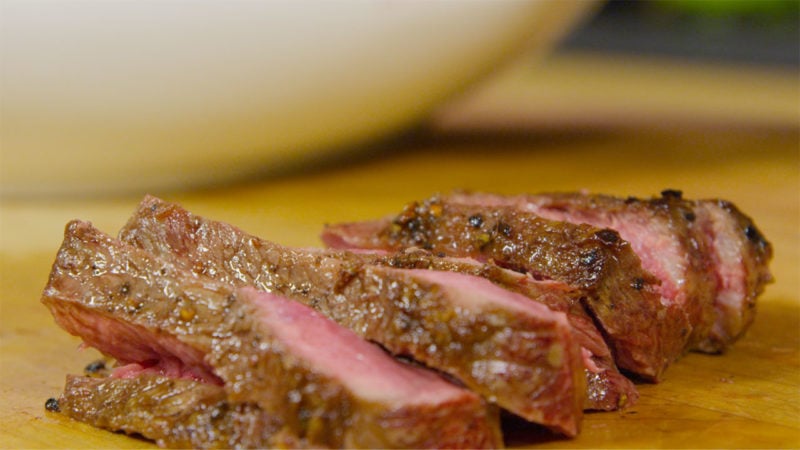Last Updated on January 28, 2025
Flat iron steak shouldn’t be so delicious.
It’s named after a domestic appliance, it can be hard to find outside of restaurants, and it comes from an area of the cow that was long considered too tough to produce any tender, enjoyable steaks.
But if you’ve ever had a perfectly cooked flat iron steak from a steakhouse or grilled one in your own backyard, you know that it is one amazing cut of beef.
The History of Flat Iron Steaks
Flat iron steak is a tender cut of beef that not only has an interesting history but also can be tough to find in stores, much like ranch steaks or Denver steaks. Though flat iron is not as prevalent in the butcher case as rib-eye, filet mignon, or flank steaks, it’s quite popular on restaurant menus in America and beyond.
Flat iron steak derives its name from its shape, which is similar to that of an old-fashioned clothes iron. The cut, or something similar to it, is known as the butler steak in the U.K. or the oyster blade steak in Australia and New Zealand. In some places, it may also be called book steak, petite steak, or shoulder top blade steak.
The cut is derived from the shoulder of the cow, specifically from the top blade of the chuck primal cut. For a long time, the area where the flat iron steak comes from was considered waste meat or used in ground beef mixes. This was due to the connective tissue that ran through it, making it undesirable as a stand-alone cut. That is, until 2002, when it was “discovered” by researchers at the University of Florida and the University of Nebraska, as part of the Beef Checkoff Program.
The popularity of the flat iron steak among chefs—a classic “bistro steak”—is due to the versatility of this flavorful cut. According to our own Chef Yankel Polak, our in-house ButcherBox chef, “The flat iron steak is an industry darling, a new-age steak.”
Preparing Flat Iron Steak
The tender cut can be cooked as is, but a rub or marinade is often used with it. It’s popular as a stir-fry meat, sometimes sliced for sandwiches, and commonly served with chimichurri or other spicy sauces for tacos.
The flat iron steak is ideal for grilling, whether using a marinade or just some oil, kosher salt, and freshly ground black pepper.
Chef Yankel says that flat iron is similar to both skirt steak and hanger steak. “For mouthfeel, it’s slightly chewy but in an enjoyable way, and for meatiness, it tastes like what you imagine beef should taste like,” he explains.
It’s a shame that the cut is difficult for steak-loving consumers to find it on their own. But luckily, if you’re a ButcherBox member, it’s often available in the monthly box–or you can find it in our Ultimate Steak Sampler box.

Ingredients
- 2 Tbsp coarsely ground black pepper
- 2 ButcherBox Flat Iron Steaks
- 1 Tbsp kosher salt
- 1 Tbsp avocado oil
Root Vegetable Mash
- 3 medium parsnips peeled and sliced
- 1 large turnip peeled and sliced
- 4 cloves garlic smashed
- 3 cups milk
- 4 Tbsp unsalted butter
- 1 Tbsp chopped fresh parsley
- ½ cup grated parmesan cheese
- Cooking spray olive oil or avocado oil
Instructions
- Preheat oven to 350℉. Place a cast iron skillet in the oven while it preheats.
- Spread the black pepper on a plate and press one side of the flat iron steaks in it. Season the steaks on both sides with salt.
- Remove the skillet from the oven, swirl the oil in it and place the steaks in the skillet pepper side down. Return the skillet to the oven and roast for 4 minutes. Flip the steaks and continue to roast until an instant-read thermometer stuck into the thickest part reads 120ºF, about 4 minutes longer.
- Remove the skillet from the oven, transfer the steaks to a cutting board, tent with foil and let rest for 8 minutes. Slice the steak against the grain and serve with the Root Vegetable Mash.
Root Vegetable Mash
- Preheat the oven to 350℉.
- In a medium saucepan, combine the parsnips, turnips, garlic and milk. Make sure the milk is covering the vegetables (add more if necessary).
- Bring to a simmer and cook until the vegetables are fork-tender, 15 to 20 minutes. Strain, reserving the cooking liquid.
- Place the vegetables in a large bowl with the butter and mash, adding small amounts of reserved cooking liquid to get a thick mashed consistency. Stir in the parmesan and parsley.
- Mist the cups of a muffin tin with cooking spray. Scoop the mashed vegetable mixture into the cups. Sprinkle the tops with black pepper and bake until golden brown, about 20 minutes.
Dennis Keohane is a writer, editor, and former Editorial Director for ButcherBox with a passion for storytelling and food. Combining his love for high-quality ingredients with engaging narratives, he crafts content that inspires home cooks to explore new flavors, techniques, and the joy of cooking.



